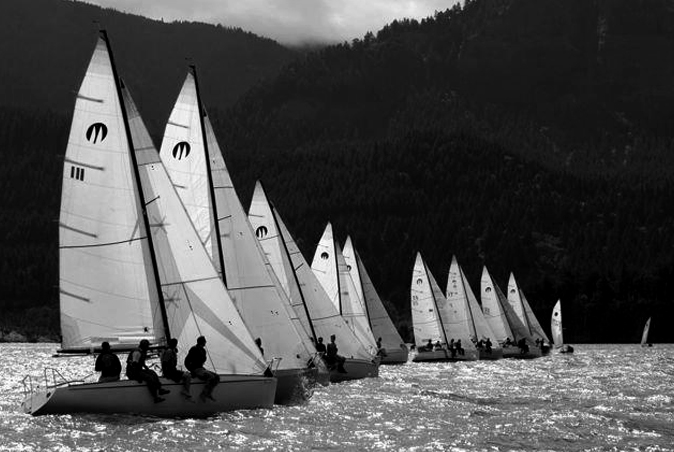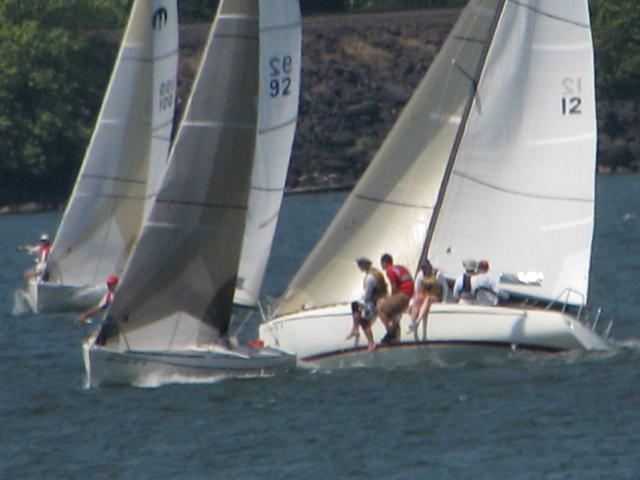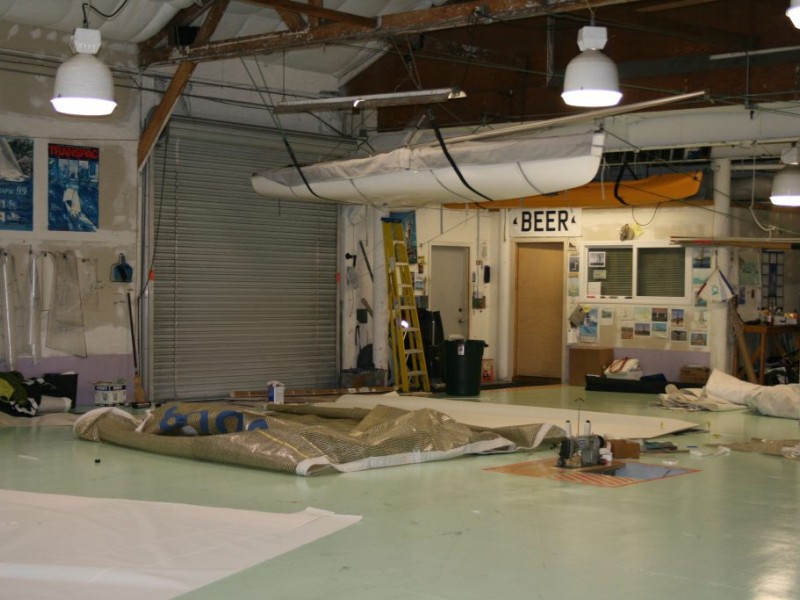The Moore 24 is a highly sensitive racing boat that must be constantly tuned relative to the wind and wave conditions. The following will attempt to explain the sail and boat trim variations relative to wind and wave conditions.
Before I go into the sail and boat tuning, there are a few things that should be discussed about rig tune. First and foremost is to get the rig straight in the boat (athwartships). After stepping the mast, take up the slack in the uppers to firm up the rig. Run a tape measure up the main halyard and measure the distance from side to side using the top of the chainplates as your measurement point. Get the difference from one side to the other within 1/8 inch. Do not get the shrouds real tight, at this point we just want to center the mast head. Now, before you tune the shrouds, check the rake.
The rake measurement is taken two ways; one with the jib halyard and the other with the main halyard. This is because of the fact that the height of the headstay is not consistent on all Moore 24's. Measurements taken from the jib halyard when hoisted all the way up are; 25.65' to base of mast (deck), and 28.15' to stem fitting at deck level. The measurement from the main halyard all the way up is 30.45' to transom at deck level when there is no tension on the back stay. Once the shrouds are tight, test to see that maximum backstay can reduce the number to at least 30.20'.
Now that the rig has been checked and is both centered athwartships and at the desired rake, you may tune the rig. First tighten the uppers until they have about 200 lbs., then sight up the mast. Tighten the lowers until the have about 300 lbs., take care to remove the "S" curve you notice when you look up the back of the mast. Continue tensioning the uppers until you reach the desired tension, about 900 lbs. In windy conditions and 700 lbs. in light to moderate conditions. Again tension the lowers to remove the "S" curve and tune them about 150 lbs. less than the uppers. The aft lowers must be tuned relative to wind strength and mainsail shape. Basically, they should be tight when you have a flat mainsail and/or you are sailing in windy conditions. And they should be looser when your main is full. The tighter they are the less your mast will bend and the tighter the headstay will become.
Upwind Trim
When sailing in light winds (0-10 knots) the single most important factor affecting boatspeed is the placement and movement of the crew weight. The boat should be heeled slightly to leeward and the weight well forward. It is especially important in light air that the movement of the crew be as smooth and graceful as possible, upsetting the boat trim as little as possible.
In the lower wind range (0-7 knots) the Moore is underpowered, so it is important to generate as much power as possible, and power equals speed. This means the backstay should be all the way off, and both the main and genoa are full and eased. The main traveler is to weather and the sheet is eased to ensure flow over the leach. The jib should be eased (9-12 inches from the spreader) and the boat is sailed "full" trying to generate as much speed as possible. Don't hesitate to ease the jib!
As the wind increases, move the weight to the weather side until most of the people are on the high side. As each person moves up, you are able to trim the sails tighter. At this time, before all the people are fully hiked out, begin to depower the boat so that you may point higher. This includes (in order of priority): Put on full flattening reef (this should be done in all but the lightest air), and pulling on the backstay about one quarter (this flattens both the main and genoa). Once these things have been done, you must have all the weight fully hiked out before you depower any more. I cannot emphasize enough how important it is to do this. The skipper and crew should sit as far out as possible, and legal.
Now that the crew weight is optimum for full power sailing, you should backstay until the backwind in the main is only about 6-8 inches from the mast. Tighten the mainsheet until the upper telltale (on the top batten) stalls completely, then ease it a little until it flows. Ultimately you want it to oscillate between stalled and flowing. Put on as little cunningham as you can get away with. This means only pull out the really big wrinkles, when you get overpowered, you pull them all out. At this point the boat can be pinched very effectively. This means the genoa can be backwinded as much as 6-8 inches. The traveller should be down in the big puffs to ensure that the boat does not stall. This technique should not be used continuously, but rather in short bursts during the puffs to keep the boat on it's feet. When the wind increases so much that the boat is overpowered in puffs (excessive heel, backwind, and leeway) you are sailing in the top end of the 150's range and the main should be fully bladed out with maximum backstay and cunningham (same with genoa). The mainsheet should only be tight enough to keep it from flogging. Pulling the traveler to windward aids in reducing the flogging. Pulling the traveler to windward also aids in reducing the flogging of the sail when using minimum sheet.
Another effective tuning technique is to sheet the genoa to the rail when sailing in puffy, overpowering conditions. This technique can be particularly effective when the range between the high and low wind velocity is over five knots (example; puff=19, lull=13). It is important in this situation to have five people on board, otherwise there is not sufficient weight to handle the big jib in these overpowering conditions. Sailing with the 150 in overpowering conditions can be very effective but is a difficult technique to master. The less experienced helmsmen may find it both easier and more efficient to change down to the #2 (115%) when such a situation arises. Be sure though that a change is definitely going to be worth the distance lost in execution, so often in close course racing it is not. Sail choice is critical!
Now that you have changed down to the #2 it should be sheeted in hard and the main should be trimmed to match the conditions. If it is a constant breeze that is on the low end of the sail range, the jib should be sheeted inboard and tight, the main should have about 3-4 inches of draft, the traveler up, and the sheet tight enough to stall the telltale periodically. Play the traveler in puffs to keep the boat on a medium angle of heel. When overpowered, the same rules apply as for the 150...pinch to gain windward performance, blade and twist the main, raise the traveller and/or sheet to the rail when necessary to reduce backwinding. This combination of the #2 sheeted to the rail proved very effective when I sailed Tonopah Low on Lake Tahoe with only four people. It was the classic lake conditions, variable and puffy. Again, change down as soon as the windward performance is being reduced due to excessive wind velocity.
When sailing with the #3 (90%), the most critical aspect of sail trim is the sheeting angle. Because of the nearly vertical leach of the 90% it is vital to get the jib lead in exactly the correct place. Too far forward and the leach becomes too hard when fully sheeted, and too far aft, the top spills even when sheeted hard. Ultimately the top batten wants to come parallel to centerline when fully sheeted.
In summary here are some rules of thumb that apply for all combinations of main and jib. When underpowered the main should have moderate depth, the boom on centerline, and a free leach. When powered up, both the sails should be flattened out, the boat should be pinched as much as possible, and the traveler played extensively. When overpowered the sails should be bladed flat and twisted to spill power. Sheeting to the rail can be effective when there is a large range between puffs and lulls, the wind is solidly above the normal range of the sail and a change is not possible, and when the waves are so big that you need extra punch to get through them (you must have plenty of weight in this situation).
Downwind Trim
The most critical thing to understand in light air is that you cannot sail the boat dead down wind. You must reach or "heat it up" to keep the sails drawing and the boat speed up. The pole is positioned approximately 30 degrees off the headstay. There is a fine line between sailing too high (sailing a longer distance) and sailing too low (with too little boatspeed) that it is best determined by looking at the other boats around you. The mainsail should be all the way out and powered up. This means the backstay, cunningham, and flattening reef should all be all the way off and the main trimmed relative to apparent wind (perpendicular). Keep the crew weight extremely far forward and to leeward, nobody in the cockpit except the helmsman, and everybody else around the shrouds.
In medium air the most efficient way to get to where you want to go is a straight line. Running dead downwind works well since there is little or no net speed advantage to reaching up. In this situation the pole is best at about 60 degrees from the headstay. The crew weight should be moved so that the trimmer is in the cockpit and the halyard man is in the hatch. The fourth and fifth person(s) should be near the mast.
In heavier wind the decision to reach up or sail dead downwind is based on two things: How much control you have when sailing dead downwind, and the degree to which you can catch waves by reaching up, no doubt when the swell is up and good size waves are developing which will enable you to get very good surfing out of the 24. To promote surfing and keep the bow from burying, move the crew weight even further aft. Vang the main to keep the wind from spilling out. This also helps keep the boat from rolling out of control. Resist raising the pole any higher as you will just make the head fly away from the boat. This in turn will cause the spinnaker to round out and loose projected area. Teamwork between the helmsman and trimmer is vital to control, and practice is the key to survival.
Pole position is critical to spinnaker trim both reaching and running. When running, the pole should be set level and at an elevation that allows the clews to be even (except in light sloppy conditions where the pole should be set lower than the opposite clew in order to stabilize the spinnaker). Reaching, the pole should be about one foot from the headstay in all but very light conditions.
Finally, here is some sheeting information for the headsails:
| Sail | Distance from Bow | Distance from Rail |
|---|---|---|
| 90% (inboard) | 10.2' | 1.2' |
| 90% (middle) | 10.2' | 0.7' |
| 115% | 13.0' | 0.7' |
| 150% | 15.9' | 0.75' |
I hope you find this information useful for getting the most out of your Moore 24. Obviously there are many conditions and situations that I cannot cover, but these pointers will help.









Show Comments (0)